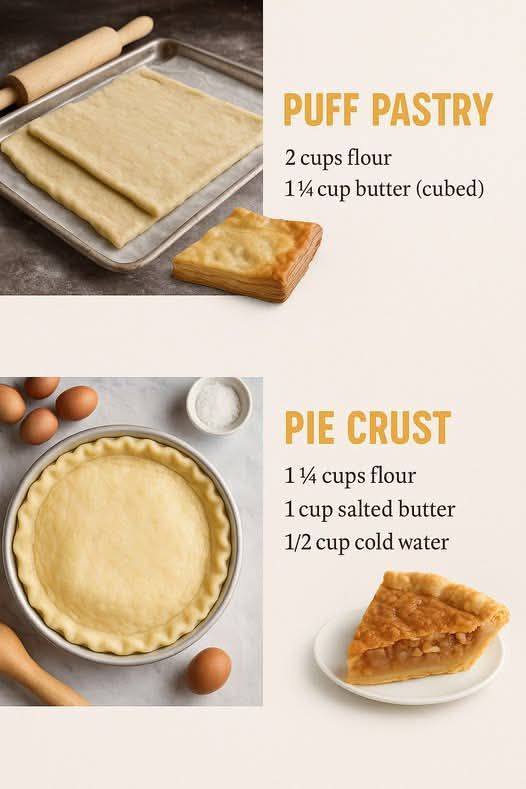Puff Pastry vs. Pie Crust: What’s the Difference?
Understanding the difference between puff pastry and pie crust helps you choose the right dough for the right recipe:
| Feature | Puff Pastry | Pie Crust |
|---|---|---|
| Ingredients | Flour, butter, water | Flour, butter, water, sugar |
| Texture | Flaky, airy, buttery layers | Tender, slightly crumbly |
| Uses | Turnovers, vol-au-vents, tarts | Pies, quiches, savory galettes |
| Technique | Folded and rolled multiple times | Mixed and rolled once |
Both recipes shine in their own ways. Puff pastry is ideal for when you want an elegant, airy finish, while pie crust gives you that classic, home-baked foundation.
How to Store Homemade Dough
Fridge: Both doughs can be stored in the fridge, wrapped in plastic, for up to 3 days.
Freezer: You can freeze them for up to 2 months. Just thaw in the refrigerator overnight before using.
Pro Tip: Roll the dough into sheets or disks before freezing to make future use quicker and easier.
Creative Ideas Using Puff Pastry Dough
Here’s where the real fun begins! Once you’ve mastered your 3-ingredient puff pastry dough, the possibilities are endless:
- Mini Fruit Tarts: Top small pastry squares with cream cheese and seasonal berries.
- Savory Pinwheels: Spread pesto or cheese, roll, slice, and bake.
- Breakfast Pastries: Fill with jam or Nutella, fold and bake for a café-style treat.
- Cheesy Twists: Sprinkle with cheese, twist the strips, and bake as a snack.
Creative Ways to Use Homemade Pie Crust
Your homemade pie crust isn’t just for dessert. Here’s how to make it work for every meal:
- Rustic Galette: Fill with veggies or fruit and fold the crust over the filling.
- Pot Pies: Use as a topping or base for creamy fillings.
- Pie Pops: Mini pie crust rounds filled with jam or chocolate and baked on a stick.
- Quiche Base: Add eggs, cheese, and veggies for a breakfast-perfect bake.
Common Mistakes to Avoid
Even the best bakers make mistakes. Here are a few pitfalls to watch for:
❌ Overworking the Dough
The more you knead or stir, the tougher your crust will be. Stop mixing as soon as it holds together.
❌ Skipping the Chill
Skipping the refrigeration step can lead to melted butter and dense dough. Always chill before rolling or baking.
❌ Using Warm Ingredients
Keep everything cold—especially your butter and water. Warm ingredients ruin flakiness.
❌ Rolling Too Thin or Thick
Aim for ⅛ to ¼ inch thickness. Too thin? It might tear. Too thick? It won’t cook evenly.
FAQs About Homemade Dough
Q: Can I make these recipes vegan?
Yes! Substitute butter with plant-based alternatives like vegan buttery sticks. Make sure they’re cold and firm.
Q: What flour is best?
All-purpose flour works perfectly for both. You can experiment with whole wheat or gluten-free blends, though texture may vary.
Q: Can I add herbs or spices to the dough?
Absolutely! Mix in dried rosemary, thyme, cinnamon, or nutmeg to complement your filling.
Final Thoughts: Your Homemade Baking Era Starts Now
There’s a deep satisfaction in baking from scratch. The kneading, folding, and even the wait—each step brings you closer to something genuinely delicious. Whether you’re planning a Sunday brunch or prepping for a cozy holiday, these dough recipes are the foundation of flaky, tender success.
So the next time you’re eyeing a frozen pastry box at the grocery store, remember: with just 3 or 4 ingredients, you can create something far better at home. Grab your flour and butter and start rolling your way to pastry perfection.

